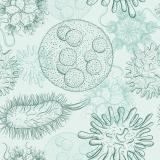Basic Information about Anaerobic Digestion (AD)
How does AD work?
Anaerobic digestion is the natural process in which microorganisms break down organic materials. In this instance, “organic” means coming from or made of plants or animals. Anaerobic digestion happens in closed spaces where there is no air (or oxygen). The initials “AD” may refer to the process of anaerobic digestion or the built system where anaerobic digestion takes place, also known as a digester.
The following materials are generally considered “organic.” These materials can be processed in a digester:
-
Animal manures;
-
Food scraps;
-
Fats, oils, and greases;
-
Industrial organic residuals; and
All anaerobic digestion systems adhere to the same basic principles whether the feedstock is food waste, animal manures or wastewater sludge. The systems may have some differences in design but the process is basically the same.
Learn more about how anaerobic digestion works
What is made during the AD process?
Biogas is generated during anaerobic digestion when microorganisms break down (eat) organic materials in the absence of air (or oxygen). Biogas is mostly methane (CH4) and carbon dioxide (CO2), with very small amounts of water vapor and other gases. The carbon dioxide and other gases can be removed, leaving only the methane. Methane is the primary component of natural gas.
The material that is left after anaerobic digestion happens is called “digestate.” Digestate is a wet mixture that is usually separated into a solid and a liquid. Digestate is rich in nutrients and can be used as fertilizer for crops.
How are the products of AD used?
-
Power engines, produce mechanical power, heat and/or electricity (including combined heat and power systems);
-
Fuel boilers and furnaces, heating digesters and other spaces;
-
Run alternative-fuel vehicles; and
-
Supply homes and business through the natural gas pipeline
Low quality biogas is typically used in tougher, less efficient engines, such as internal combustion engines. Higher quality biogas cleaned of trace contaminants can be used in more efficient, but also more sensitive engines.
Biogas treated to meet pipeline quality standards can be distributed through the natural gas pipeline and used in homes and businesses. Biogas can also be cleaned and upgraded to produce compressed natural gas (CNG) or liquefied natural gas (LNG). CNG and LNG can be used to fuel cars and trucks.
Learn more about clean fuels/alternative fuels
-
Bedding for livestock;
-
Flower pots;
-
Soil amendments; and
-
Fertilizers.
Digestate can be directly land applied and incorporated into soils to improve soil characteristics and facilitate plant growth. Digestate can also be further processed into products that are bagged and sold in stores. Some emerging technologies can be employed post-digestion to recover the nitrogen and phosphorus in digestate and create concentrated nutrient products, such as struvite (magnesium-ammonium-phosphate) and ammonium sulfate fertilizers.

